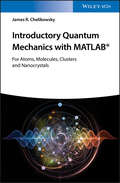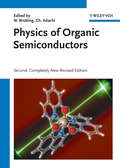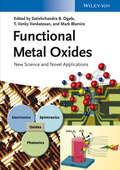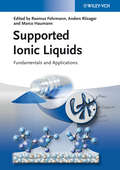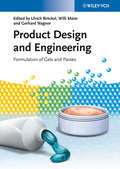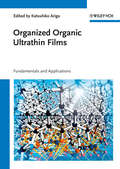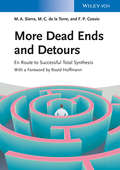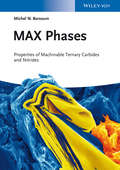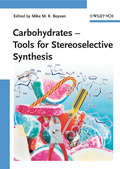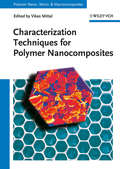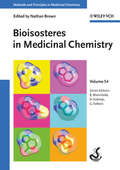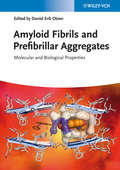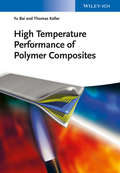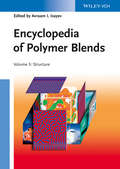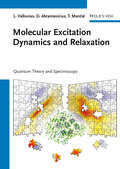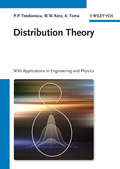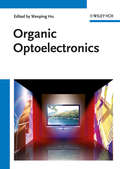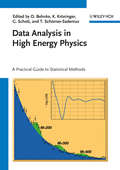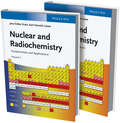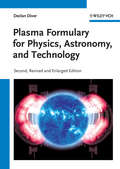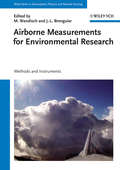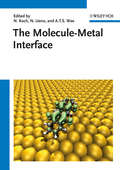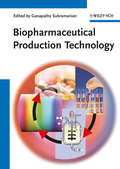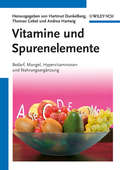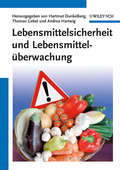- Table View
- List View
Introductory Quantum Mechanics with MATLAB: For Atoms, Molecules, Clusters, and Nanocrystals
by James R. ChelikowskyPresents a unique approach to grasping the concepts of quantum theory with a focus on atoms, clusters, and crystals Quantum theory of atoms and molecules is vitally important in molecular physics, materials science, nanoscience, solid state physics and many related fields. Introductory Quantum Mechanics with MATLAB is designed to be an accessible guide to quantum theory and its applications. The textbook uses the popular MATLAB programming language for the analytical and numerical solution of quantum mechanical problems, with a particular focus on clusters and assemblies of atoms. The textbook is written by a noted researcher and expert on the topic who introduces density functional theory, variational calculus and other practice-proven methods for the solution of quantum-mechanical problems. This important guide: -Presents the material in a didactical manner to help students grasp the concepts and applications of quantum theory -Covers a wealth of cutting-edge topics such as clusters, nanocrystals, transitions and organic molecules -Offers MATLAB codes to solve real-life quantum mechanical problems Written for master's and PhD students in physics, chemistry, material science, and engineering sciences, Introductory Quantum Mechanics with MATLAB contains an accessible approach to understanding the concepts of quantum theory applied to atoms, clusters, and crystals.
Physics of Organic Semiconductors
by Wolfgang Brütting Chihaya AdachiThe field of organic electronics has seen a steady growth over the last 15 years. At the same time, our scientific understanding of how to achieve optimum device performance has grown, and this book gives an overview of our present-day knowledge of the physics behind organic semiconductor devices. Based on the very successful first edition, the editors have invited top scientists from the US, Japan, and Europe to include the developments from recent years, covering such fundamental issues as: - growth and characterization of thin films of organic semiconductors, - charge transport and photophysical properties of the materials as well as their electronic structure at interfaces, and - analysis and modeling of devices like organic light-emitting diodes or organic lasers. The result is an overview of the field for both readers with basic knowledge and for an application-oriented audience. It thus bridges the gap between textbook knowledge largely based on crystalline molecular solids and those books focusing more on device applications.
Functional Metal Oxides
by T. Venky Venkatesan Satishchandra Balkrishna Ogale Mark BlamireThis forward-looking title focuses on the key innovations for industrial growth areas for functional metal oxides: energy technology, semiconductors, electronics, and automotive.Bridging the gap between basic science and technological applications, the book covers the full range of topics in the field of advanced metal oxide science and technology such as metallic, semiconducting, insulating, ferromagnetic, superconducting, ferroelectric, and multiferroic metal oxide systems and their engineered interface systems. It emphasizes many of the modern applications of metal oxides in solar cells, batteries, catalysis and for resistive switches. Chapters about the growth and processing of oxidic thin films and nanomaterials round the topic out.
Supported Ionic Liquids
by Marco Haumann Anders Riisager Rasmus FehrmannThis unique book gives a timely overview about the fundamentals and applications of supported ionic liquids in modern organic synthesis. It introduces the concept and synthesis of SILP materials and presents important applications in the field of catalysis (e.g. hydroformylation, hydrogenation, coupling reactions, fine chemical synthesis) as well as energy technology and gas separation. Written by pioneers in the field, this book is an invaluable reference book for organic chemists in academia or industry.
Product Design and Engineering
by Gerhard Wagner Ulrich Bröckel Willi MeierCovering the whole value chain - from product requirements and properties via process technologies and equipment to real-world applications - this reference represents a comprehensive overview of the topic. The editors and majority of the authors are members of the European Federation of Chemical Engineering, with backgrounds from academia as well as industry. Therefore, this multifaceted area is highlighted from different angles: essential physico-chemical background, latest measurement and prediction techniques, and numerous applications from cosmetic up to food industry.Recommended reading for process, pharma and chemical engineers, chemists in industry, and those working in the pharmaceutical, food, cosmetics, dyes and pigments industries.
Organized Organic Ultrathin Films
by Katsuhiko ArigaThis handy reference is the first comprehensive book covering both fundamentals and recent developments in the field with an emphasis on nanotechnology.Written by a highly regarded author in the field, the book details state-of-the-art preparation, characterization and applications of thin films of organic molecules and biomaterials fabricated by wet processes and also highlights applications in nanotechnologyThe categories of films covered include monomolecular films (monolayers) both on a water surface and on a solid plate, Langmuir-Blodgett films (transferred multilayer films on a solid plate from a water surface), layer-by-layer films (adsorbed multilayer films on a solid support), and spontaneously assembled films in solution.
More Dead Ends and Detours
by Miguel A. Sierra Roald Hoffmann Maria C. de la Torre Fernando P. CossioSuccess comes in many forms and in synthesis it can be a failure that results in their ultimate successful solutions. This long-awaited sequel to "Dead Ends and Detours" retains the proven concept while featuring over 20 new case studies of failed strategies and their (successful) solutions in natural product total synthesis. Additionally, computational models are used to discuss the problem in much more detail and to provide readers with additional information not found in the primary literature. The topics range from classic synthetic reactions (e.g. Diels Alder reaction), metal-mediated coupling reactions, metathesis, and asymmetric catalysis to the importance of protecting and activating groups.This book will benefit not only graduate students in organic chemistry but also advanced researchers as they gain knowledge derived from the step-by-step analysis of mistakes made in the past and, thus be able to improve their own chemical reaction planning. With its coverage of the most commonly applied reaction types, the book perfectly complements its predecessor, which focuses on general aspects, such as reactivity and selectivity.
MAX Phases
by Michel W. BarsoumIn this comprehensive yet compact monograph, Michel W. Barsoum, one of the pioneers in the field and the leading figure in MAX phase research, summarizes and explains, from both an experimental and a theoretical viewpoint, all the features that are necessary to understand and apply these new materials. The book covers elastic, electrical, thermal, chemical and mechanical properties in different temperatureregimes.By bringing together, in a unifi ed, self-contained manner, all the information on MAX phases hitherto only found scattered in the journal literature, this one-stop resource offers researchers and developers alike an insight into these fascinating materials.
Carbohydrates
by Mike Martin BoysenClosing a gap in the literature, this comprehensive book presents the utility of carbohydrate derivatives as chiral auxiliaries, reagents, complexligands and organocatalysts, together with details of their preparation, as well as their successful application in stereoselective synthesis.Divided into four parts:* Carbohydrate Auxiliaries* Carbohydrate Reagents* Carbohydrate Ligands* Carbohydrate OrganocatalystsIt is an indispensable source for every organic chemist.
Characterization Techniques for Polymer Nanocomposites
by Vikas MittalWith its focus on the characterization of nanocomposites using such techniques as x-ray diffraction and spectrometry, light and electron microscopy, thermogravimetric analysis, as well as nuclear magnetic resonance and mass spectroscopy, this book helps to correctly interpret the recorded data. Each chapter introduces a particular characterization method, along with its foundations, and makes the user aware of its benefits, but also of its drawbacks.As a result, the reader will be able to reliably predict the microstructure of the synthesized polymer nanocomposite and its thermal and mechanical properties, and so assess its suitability for a particular application.Belongs on the shelf of every product engineer.
Bioisosteres in Medicinal Chemistry
by Nathan Brown Raimund Mannhold Gerd Folkers Hugo KubinyiWritten with the practicing medicinal chemist in mind, this is the first modern handbook to systematically address the topic of bioisosterism.As such, it provides a ready reference on the principles and methods of bioisosteric replacement as a key tool in preclinical drug development.The first part provides an overview of bioisosterism, classical bioisosteres and typical molecular interactions that need to be considered,while the second part describes a number of molecular databases as sources of bioisosteric identification and rationalization. The third partcovers the four key methodologies for bioisostere identification and replacement: physicochemical properties, topology, shape, and overlays ofprotein-ligand crystal structures. In the final part, several real-world examples of bioisosterism in drug discovery projects are discussed.With its detailed descriptions of databases, methods and real-life case studies, this is tailor-made for busy industrial researchers with little time for reading, while remaining easily accessible to novice drug developers due to its systematic structure and introductory section.
Amyloid Fibrils and Prefibrillar Aggregates
by Daniel Erik OtzenSumming up almost a decade of biomedical research, this topical and eagerly awaited handbook is the first reference on the topic to incorporate recent breakthroughs in amyloid research.The first part covers the structural biology of amyloid fibrils and pre-fibrillar assemblies, including a description of current models for amyloid formation. The second part looks at the diagnosis and biomedical study of amyloid in humans and in animal models, while the final section discusses pharmacological approaches to manipulating amyloid and also looks at its physiological roles in lower and higher organisms. For Biochemists, Molecular Biologists, Neurobiologists, Neurophysiologists and those working in the Pharmaceutical Industry.
High Temperature Performance of Polymer Composites
by Thomas Keller Yu BaiThe authors explain the changes in the thermophysical and thermomechanical properties of polymer composites under elevated temperatures and fire conditions. Using microscale physical and chemical concepts they allow researchers to find reliable solutions to their engineering needs on the macroscale. In a unique combination of experimental results and quantitative models, a framework is developed to realistically predict the behavior of a variety of polymer composite materials over a wide range of thermal and mechanical loads. In addition, the authors treat extreme fire scenarios up to more than 1000?C for two hours, presenting heat-protection methods to improve the fire resistance of composite materials and full-scale structural members, and discuss their performance after fire exposure.Thanks to the microscopic approach, the developed models are valid for a variety of polymer composites and structural members, making this work applicable to a wide audience, including materials scientists, polymer chemists, engineering scientists in industry, civil engineers, mechanical engineers, and those working in the industry of civil infrastructure.
Encyclopedia of Polymer Blends, Volume 3: Structure (Encyclopedia of Polymer Blends)
by Avraam I. IsayevA complete and timely overview of the topic, this Encyclopedia imparts knowledge of fundamental principles and their applications for academicians, scientists and researchers, while informing engineers, industrialists and entrepreneurs of the current state of the technology and its utilization. The most comprehensive source on polymer blends available on the market Offers a complete and timely overview of the topic Each article presents up to date research & development on a topic and its basic principles and applications, integrates case studies, laboratory and pilot plant experiments, and gives due reference to published and patented literature Equips academics, scientists and researchers with knowledge of fundamentals principles and their applications, and informs the engineers, industrialists and entrepreneurs about the state of the art technology and its applications
Molecular Excitation Dynamics and Relaxation: Quantum Theory and Spectroscopy, 1st Edition
by Darius Abramavicius Leonas Valkunas Tomás MancalThis work brings together quantum theory and spectroscopy to convey excitation processes to advanced students and specialists wishing to conduct research and understand the entire fi eld rather than just single aspects.Written by experienced authors and recognized authorities in the field, this text covers numerous applications and offers examples taken from different disciplines. As a result, spectroscopists, molecular physicists, physical chemists, and biophysicists will all fi nd this a must-have for their research. Also suitable as supplementary reading in graduate level courses.
Distribution Theory
by Petre Teodorescu Antonela Toma Wilhelm W. KecsIn this comprehensive monograph, the authors apply modern mathematical methods to the study of mechanical and physical phenomena or techniques in acoustics, optics, and electrostatics, where classical mathematical tools fail.They present a general method of approaching problems, pointing out different aspects and difficulties that may occur. With respect to the theory of distributions, only the results and the principle theorems are given as well as some mathematical results. The book also systematically deals with a large number of applications to problems of general Newtonian mechanics, as well as to problems pertaining to the mechanics of deformable solids and physics. Special attention is placed upon the introduction of corresponding mathematical models.Addressed to a wide circle of readers who use mathematical methods in their work: applied mathematicians, engineers in various branches, as well as physicists, while also benefiting students in various fields.
Organic Optoelectronics
by Xiong Gong Thomas Bjornholm Wenping Hu Hongbing Fu Xiaowei Zhan Fenglian BaiWritten by internationally recognized experts in the field with academic as well as industrial experience, this book concisely yet systematicallycovers all aspects of the topic. The monograph focuses on the optoelectronic behavior of organic solids and their application in new optoelectronic devices. It covers organic field-effect and organic electroluminescent materials and devices, organic photonics, materials and devices, as well as organic solids in photo absorption and energy conversion. Much emphasis is laid on the preparation of functional materials and the fabrication of devices, from materials synthesis and purification, to physicochemical properties and the basic processes and working principles of the devices.The only book to cover fundamentals, applications, and the latest research results, this is a handy reference for both researchers and thosenew to the field.From the contents:* Electronic process in organic solids* Organic/polymeric semiconductors for field-effect transistors* Organic/polymeric field-effect transistors* Organic circuits and organic single molecular transistors* Polymer light-emitting Diodes (PLEDs): devices and materials* Organic solids for photonics* Organic photonic devices* Organic solar cells based on small molecules* Polymer solar cells* Dye-sensitized solar cells (DSSCs)* Organic thermoelectric power devices
Data Analysis in High Energy Physics
by Thomas Schörner-Sadenius Kevin Kröninger Olaf Behnke Grégory SchottThis practical guide covers the essential tasks in statistical data analysis encountered in high energy physics and provides comprehensive advice for typical questions and problems. The basic methods for inferring results from data are presented as well as tools for advanced tasks such as improving the signal-to-background ratio, correcting detector effects, determining systematics and many others. Concrete applications are discussed in analysis walkthroughs. Each chapter is supplemented by numerous examples and exercises and by a list of literature and relevant links. The book targets a broad readership at all career levels - from students to senior researchers. An accompanying website provides more algorithms as well as up-to-date information and links.* Free solutions manual available for lecturers at www.wiley-vch.de/supplements/
Nuclear and Radiochemistry
by Karl Heinrich Lieser Jens-Volker KratzThe third edition of this classic in the field is completely updated and revised with approximately 30% new content so as to include the latest developments.The handbook and ready reference comprehensively covers nuclear and radiochemistry in a well-structured and readily accessible manner, dealing with the theory and fundamentals in the first half, followed by chapters devoted to such specific topics as nuclear energy and reactors, radiotracers, and radionuclides in the life sciences. The result is a valuable resource for both newcomers as well as established scientists in the field.
Plasma Formulary for Physics, Astronomy, and Technology
by Declan DiverThis collection of fundamental formulae, up-to-date references and definitions in plasma physics is vital to anyone with an interest in plasmas or ionized gases, whether in physics, astronomy or engineering. <P><P>Both theorists and experimentalists will find this book useful, as it incorporates the latest results and findings, with extended coverage of fusion plasma, plasma in stellar winds, reaction rates, engineering plasma and many other topics. The text is also unique in treating astrophysical plasmas, fusion plasmas, industrial plasmas and low temperature plasmas as aspects of the same discipline.
Airborne Measurements for Environmental Research
by Jean-Louis Brenguier Manfred WendischThis first comprehensive review of airborne measurement principles covers all atmospheric components and surface parameters. It describes the common techniques to characterize aerosol particles and cloud/precipitation elements, while also explaining radiation quantities and pertinent hyperspectral and active remote sensing measurement techniques along the way. As a result, the major principles of operation are introduced and exemplified using specific instruments, treating both classic and emerging measurement techniques.The two editors head an international community of eminent scientists, all of them accepted and experienced specialists in their field, who help readers to understand specific problems related to airborne research, such as immanent uncertainties and limitations. They also provide guidance on the suitability of instruments to measure certain parameters and to select the correct type of device. While primarily intended for climate, geophysical and atmospheric researchers, its relevance to solar system objects makes this work equally appealing to astronomers studying atmospheres of solar system bodies with telescopes and space probes.
The Molecule-Metal Interface
by Nobuo Ueno Andrew Thye Wee Norbert KochReviewing recent progress in the fundamental understanding of the molecule-metal interface, this useful addition to the literature focuses on experimental studies and introduces the latest analytical techniques as applied to this interface. The first part covers basic theory and initial principle studies, while the second part introduces readers to photoemission, STM, and synchrotron techniques to examine the atomic structure of the interfaces. The third part presents photoelectron spectroscopy, high-resolution UV photoelectron spectroscopy and electron spin resonance to study the electronic structure of the molecule-metal interface. In the closing chapter the editors discuss future perspectives. Written as a senior graduate or senior undergraduate textbook for students in physics, chemistry, materials science or engineering, the book's interdisciplinary approach makes it equally relevant for researchers working in the field of organic and molecular electronics.
Biopharmaceutical Production Technology
by Ganapathy SubramanianCost-effective manufacturing of biopharmaceutical products is rapidly gaining in importance, while healthcare systems across the globe are looking to contain costs and improve efficiency. To adapt to these changes, industries need to review and streamline their manufacturing processes.This two volume handbook systematically addresses the key steps and challenges in the production process and provides valuable information for medium to large scale producers of biopharmaceuticals. It is divided into seven major parts:- Upstream Technologies- Protein Recovery- Advances in Process Development- Analytical Technologies- Quality Control- Process Design and Management- Changing Face of ProcessingWith contributions by around 40 experts from academia as well as small and large biopharmaceutical companies, this unique handbook is full of first-hand knowledge on how to produce biopharmaceuticals in a cost-effective and quality-controlled manner.
Vitamine und Spurenelemente: Bedarf, Mangel, Hypervitaminosen und Nahrungsergänzung
by Thomas Gebel Andrea Hartwig Hartmut DunkelbergExpertenwissen für jedermann: Diese Auskopplung aus dem "Handbuch der Lebensmitteltoxikologie" beschreibt umfassend und kompetent die für die Ernährung wichtigsten Vitamine und Spurenelemente.
Lebensmittelsicherheit und Lebensmitteluberwachung
by Thomas Gebel Andrea Hartwig Hartmut DunkelbergExpertenwissen für jedermann: Diese Auskopplung aus dem "Handbuch der Lebensmitteltoxikologie" beschreibt umfassend und kompetent heute verwendeten Methoden und Verfahren der Lebensmittelüberwachung.
